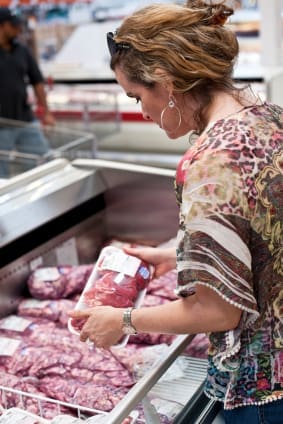THERE’S been a solid rise in domestic wholesale beef prices recently, with many popular cuts and grinding meat now 15-20 percent higher in value than they were in December.
That’s come despite a sharp rise in production during February and early March, with some recent weekly national beef kills hitting four-year highs above 128,000 head.
 Barbecue cuts remain in strong demand, and will continue to do so up to Easter, before non-grilling winter cuts start to come back into greater demand, one domestic meat trader told Beef Central this morning.
Barbecue cuts remain in strong demand, and will continue to do so up to Easter, before non-grilling winter cuts start to come back into greater demand, one domestic meat trader told Beef Central this morning.
Retail prices – either in supermarkets or independent butchers – had not yet really shown adjustment to the higher wholesale raw material values, he said.
Good quality grainfed cube rolls are making around $26/kg in the domestic wholesale market this week. Some of those lines are up around $5/kg or close to 20pc in value on December prices.
Part of that is evidently due to pressure being taken off the domestic market, as more product is shipped offshore. February beef exports, for example, where the highest in-month total volume seen since 2019.
Better quality grainfed rumps are wholesaling this week in a range from $11 to $13/kg for good examples. Some of the rump categories are now up 15pc on December prices, but that was coming off a low base, traders said.
Other primals like good quality topsides and rounds are fetching in the $10-$11/kg range this week, suggesting rumps are still the value cut in the trade at present.
“Remember, December meat trade was pretty grim, as consumers worldwide were showing signs of cautionary spending,” a trade contact said. “And exporters weren’t writing much business, to help take pressure off the domestic wholesale market. Product just kept coming.”
He said wholesalers, particularly in the Sydney and Melbourne markets, were starting to stockpile chucks, blades, rounds and knuckles now for cooler-weather slow cooker trade – “because if you don’t have the stock on hand when the demand switches, you can miss out,” he said.
Prices for those non-grilling primals had also strengthened, partly driven by the trim complex.
Domestic trimmings and manufacturing meat prices have also risen since December, but some stakeholders were reluctant to share representative prices, in what they say is currently a “fairly fluid market.”
“There’s some big spreads about for trimmings. Every packer is different at present, driven by exactly how many export orders they have in front of them,” he said.
Lower rates of slaughter on cows has also produced less manufacturing meat, as a proportion of overall beef production.
As an indicator, Australian export trimmings into the US market, which have a strong bearing on local wholesale prices, were last week trading around A855c/kg FAS, up 65c/kg since late January.
Consumer demand holding up ‘OK’
Domestic beef demand routinely falls in a bit of a hole in early February, as households have holiday and back-to-school bills to pay, one wholesaler told Beef Central.
“But March hasn’t been too bad, demand wise,” he said. “Nobody’s setting the world on fire, but it’s been OK,” he said.
One of the big features in the wholesale market at present has been the run-down in cold storage stocks. Late last year, stocks held in cold storage, both in Australia and a number of key customer countries, built up significantly, as product pushed back from export trade into the domestic channel.
“But nobody in the trade wants to hold a lot of stock at present,” a wholesale trader said.
“Customers don’t mind if they miss out on an offer at the moment, because they know there is more coming. Last year, customers would buy more than they needed, because they were worrying about missing out. Now, they don’t care – weekly kills are well up on last year, and they haven’t missed out on supply for a while.”
“Having said that, there’s still a bit of older meat in the system, but it is rapidly disappearing.”
US demand impact on domestic
The wholesale trade contact said all eyes were on any developments in the US market, which if it started to ‘really take off’, could strain product availability in the domestic wholesale market.
“The packers have been singing from the USA demand song-sheet for the past six months, but it hasn’t really come to anything yet. We’re sick of hearing it: if it happens it happens, but at this point there’s comfortable supply available in the domestic market,” he said.
“But there’s no doubt that a lift in pace of exports into the US some time this year will pressure wholesale (and retail) meat prices in Australia.”
He said the outlook ahead for domestic wholesale looked like being around ‘value.’
“Those higher-end lines like Wagyu and longer fed Angus may struggle for a while. Consumers don’t want to pay a premium, in what is already a rising beef market.
“Some of the big end-users for Angus and Wagyu in places like China, which aren’t firing at present, mean that some of those programs may be forced to look for a ‘plan B’ as the year unfolds.”
